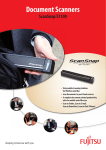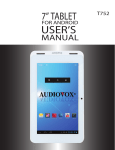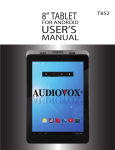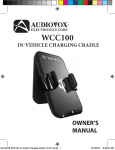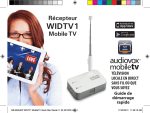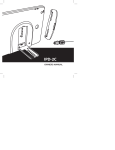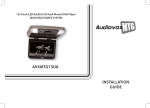Download Audiovox SCO1 Owner`s manual
Transcript
OWNER’S MANUAL AND INSTALLATION INSTRUCTIONS FOR SINGLE SEAT WARMER SKS1, SKL2, SCO1, SCO2, SSP1 CONTENTS Thank you for choosing a Audiovox product. We hope you will find the instructions in this owner’s/installation manual clear and easy to follow. If you take a few minutes to look through it, you’ll learn how to use all the features of your new seat warmer for maximum enjoyment. Cautions 2 Kit Features 3 Installation Preparation 3 Seat Cushion 4 Back Rest 9 Seat Heater Switch 9 Seat Heater Wire Harness 10 Final Seat Assembly 10 System Operation 11 Seat Heater Use 11 Troubleshooting 12 Wiring Diagram 13 Seat Heater Specifications 14 Warranty 15 CAUTION • Do not place any heavy, sharp or pointed objects on the seats. • Any fluid spilled on the seats may destroy the seat heater and may cause damage to the vehicle. Never operate the seat heater while the seats are wet or soaked with fluid. • Do not keep insulating material (sheets, covers, coats) on the seats while the seat heater is running. Do not place heat sensitive objects on the seats while the seat heater is running. • To protect damage and discharge of the battery, avoid seat heater operation for extensive time periods without a running engine. • Individuals, extra sensitive to heat, should only operate the seat heater in the “LO” position. 2 KIT FEATURES Two Carbon Fiber Heater Pads Wire Harness with In-Line Fuse Round Switch with LED Indicator 8 Large Wire Ties INSTALLATION PREPARATION 1. S eat heater system will NOT work on seats manufactured using the “foam in place” (trim cover glued to foam pad) method of trim cover attachment. 2. I f the vehicle is equipped with an anti-theft radio, the radio code must be written down prior to disconnecting battery cable. The code must be reentered when the negative battery cable is re-installed. 3. I f vehicle is equipped with an air bag, it is advisable to disconnect negative battery cable for 3 minutes prior to beginning installation. 4. O nly use parts and components supplied in kit for the seat heater installation. The supplied components are carefully selected for optimal performance. Foreign parts may lead to problems which could result in potential damage to the seat heater components or vehicle. NOTE: The installation of the heating pads must be free of creases and wrinkles. 6.Seats in vehicles with pre-loaded (power charge equipped) safety belts must be removed and re-installed under strict adherence to the vehicle manufacturers instructions. 7.In cases where a seat is equipped with an occupant pressure sensor for air bag deployment; please refer to the manufacturer’s manual for any specific instruction with regard to installing seat heater kits. 8.After installing seat heater wire harness, care must be taken to ensure all seat motions are still possible without obstruction and the moving of the seat does not cause any interference that could damage the seat heater wire harness. 9.Installation of a seat heater system with seats containing seam lines running front to rear (length wise) is not permitted. Only exception is if the heating pads are not directly located over the groove/s. 10.The overall side to side (width) of the heating pads must not be altered 3 CAUTION: Do NOT cut the side of the heating pad. 11. Both heating pads must be connected to ensure system functions properly. The SCO1, SCO2 and SSP1 are premium, pre-cut pads that are designed to allow for quick installation on seats with vertical or horizontal listings. No cutting or taping required by the installer. WARNING: Metal, electrical conductors or hog rings are not to be placed on, through or across the heating element. WARNING: Do not tap or solder seat heater harness to any airbag circuits. Yellow tape, tubing and connectors will indicate airbag circuits. WARNING: Do not tap or solder seat heater harness to any pre-loaded safety belt circuits. Installation Parts Description Quantity Seat Heater Pad 2 Wire Harness Assembly 1 Switch Assembly 1 Wire Ties 8 Seat Cushion 1. P rior to removing seat from vehicle, lay heating pads on seat to verify size and fit. 2. Park and secure the vehicle on a level surface. 3. D isconnect the negative battery cable. If you have any doubt concerning the layout of the vehicle wire harness, consult the wiring diagram provided by the manufacturer. 4. Remove seat from vehicle and place on a suitable work table/area. NOTE: Make certain to disconnect all wire connectors prior to removing seat from vehicle. 4 5. D isassemble seat as needed to gain access to seat cushion cover attachment clips. 6. U nsnap j-clips and or remove “hog ring” clips and peel back cover. Refer to Figures 1 and 2. Figure 1 Figure 2 NOTE: If trim cover has hook and loop style tie down, care must be taken when removing cover. 5 7. Measure the width of the center seat area between the longitudinal seams. NOTE: The width must be at least 10 inches (250 mm). The heating pad CANNOT contact the side seems of the seat. If it does make contact, the seat heater cannot be installed. Refer to Figure 3. Figure 3 The SCO1, SCO2 and SSP1 are premium, pre-cut pads that are designed to allow for quick installation on seats with vertical or horizontal listings. No cutting or taping required by the installer. If using one of these models, proceed to step 11 and simply install following the general installation instructions. 8. P osition the heating pad with the label facing down and the wire harness routed towards the back of the seat area. Adjust the pad so the thermostat is located approximately 1-2 inches (25-50 mm) forward of the back rest. In cases where the seat cushion contains lateral grooves (side to side) to allow for trim cover attachment, a section of the heating pad will need to be cut out. Refer to Figure 4. Figure 4 6 9. O nce the area that needs to be cut out is marked, remove the heating pad from the cushion. Measure in (towards Center of pad) on each side 1 9/16 inch (40mm) and mark. This is necessary to ensure that the main power supply for the heating pad does not get damaged or cut. Refer to Figure 5. 1 9/16 Inch 40mm 1 9/16 Inch 40mm Figure 5 10. Cut out the marked area. With the section removed, wrap the lateral “bridges” with the black insulation tape. Repeat procedure on remaining sides of the cut out. Refer to Figure 6. Figure 6 7 11. Reposition heating pad onto cushion foam. Make sure the thermostat is in the correct location. Refer to Step 9. Using the supplied double sided tape, attach the back edge of the heating pad to the cushion foam. With the pad attached at the rear, determine the final length. NOTE: Make sure that the length difference between the cushion pad and back rest pad is not more than 10-3/4 inches (275 mm). Refer to Figure 7. Figure 7 12. Trim if needed. NOTE: The seat heater pad should reach the forward edge of the seat cushion. Refer to Figure 8. Figure 8 8 13. Route the heating pad wire harness so that it exits the trim cover in an inconspicuous area. 14. Installation is now complete. NOTE: Double check to make sure the pad does not have any wrinkles or is folded over onto itself. Once checked, carefully re-attach trim cover Back Rest 1. F ollow the same order and procedures for steps 5-13 for installing the heating pad to the back rest. NOTE: For step 11, use the tape that is on the pads. One at the top and the other approximately half way down to ensure the pad will not loosen and wrinkle over time due to effects of gravity. Seat Heater Pad Wire Harness Routing/Attachment 1. R oute wires from cushion & back to underside of seat. Use supplied wire ties to fasten harness to seat. WARNING: Make sure attachment locations will NOT interfere with any seat movement. Seat Heater Switch 1. W ith the seat still removed from vehicle, choose a switch location on a flat surface where the wires won’t interfere with any seat movement. 2. Mark the location and drill a 3/4 inch (19.5 mm) hole using a stepped drill bit. NOTE: Hand filing may be required for final fitting. 3. Insert switch through opening and snap into place. 9 Seat Heater Wire Harness 1. Remove vehicle scuff plate and kick panel. 2. S tarting under seat, route the main harness through carpet opening toward scuff plate. Route the harness along scuff plate towards the underside of dash. NOTE: If an opening in carpet does not exist, create one as required. 3. U sing a digital volt/ohm meter, locate a switched ignition circuit that is capable of handling a 10A continuous current and attach using one of the supplied T-tap connectors. Use red T-tap for 18-22 gauge wire, blue T-tap for 16-14 gauge wire or yellow T-tap for 12-10 gauge wire. Attach spade connector to seat heater harness red wire and connect to T-tap. NOTE: Improper installation could drain your battery if you attach the seat heater harness to a constant battery source. WARNING: Never use engine control/ECM, safety device, ABS/ARS or engine cooling fan, etc. to power the seat heater circuit. 4. A ttach ring connector on the black harness wire to a suitable ground source at vehicle. NOTE: A T-tap and spade connector can also be used if needed. Tap/splice into only one vehicle circuit per seat heater harness. Final Seat Assembly 1. Re-assemble remaining components of seat. 2. Load seat into vehicle. Do not install mounting fasteners. 3. R e-connect vehicle harness connectors. Connect seat heater switch, main power and heating elements to seat heater harness. NOTE: Heating elements can be plugged into either connector. 4. I nstall seat mounting fasteners and torque to manufacturers recommended specifications. 10 5. R e-connect the negative battery cable and test the seat heater function to ensure it is operating correctly. 6. Re-check all systems and accessories where components were removed or relocated during the installation process. 7. Re-install vehicle scuff plate and kick panel. System Operation A seat heater kit contains two (2) heater pads: one (1) for the cushion and one (1) for the back To realize two heating levels (not available on all models), the two pads are connected serially for the “LOW” position and in parallel for the “HIGH” position. This configuration gives a lower rate for the “LOW” position and 100% for the “HIGH” position. To avoid overheating, each pad has its own thermostat, which interrupts the electrical circuit at a temperature of 158°F (70°C). Seat Heater Use The seat heater is designed to control the temperature of the lower and upper seat segment of the front seats. Proper temperature control of the vehicle seat increase the driver‘s and front passenger comfort. The seat heater operates in two power levels and can only be activated with the ignition turned on. The switch label “HI” is best used to power up the seat heater in cold ambient temperatures. After the system is operational for a while the seat heater should be switched to the “LO” position for maximum comfort. This keeps the system from generating too much heat when running continuously. The low position will provide the best comfort for normal operating conditions. The seat heater may be turned “OFF” by placing the rocker switch in the center position. The seat heater is equipped with safety device which senses and prohibits overheat conditions. If the seat heater is operated for extended period of time in the “HI” position, it may be possible for the thermo probe to shut the heater down. In such event it may take a few minutes until the system reactivates without intervention from the driver (provided the switch is still in the on position). A 10 Amp fuse protects against electrical shorts and other malfunctions. 11 Troubleshooting: If system does not heat up or no indication of power. Check fuse in seat heater harness and vehicle. Temperature of seat may be above the preset thermostat temperature and will not allow it to come on. (ie: sun shining on seat) If the light on the heated seat switch does not come on, it could be that the switch bulb is burnt out (replace switch) or that there is no power to the switch. Ensure that all connectors are properly connected and that the ground wire is properly grounded. Refer to Figure 9 for wiring diagram. Using a digital ohm meter, test only the heating elements (switch not included) from the under seat wire connector. If no resistance is found, then an open condition exists. Check internal wire connectors for an open circuit. If a heating element has an open, install a new heating element. If the heating elements and seat harness tests OK, then a power supply problem exists. Using a digital volt meter, start at the source and trace back through all the connectors and switch to determine where the power loss is occurring. Repair as necessary. If the seat heater fuse continues to blow, then a short or bad ground condition exists in the power circuit. If the vehicle fuse which has the heated seat T-tap connected to it continues to blow, then the tap will need to be moved to another vehicle circuit. 12 Wiring Diagram: Heater Element Cushion Heater Element Back Rest Connectors 2-Pin / White Relay Switch Connector 4-Pin / White 10A Fuse Switched Ignition Source Ground Figure 9 13 Seat Heater Specifications Note: All data are valid for the non-trimmed heater pad. Heater Pads: Size Varies by model Thermostat Bi-Metal switch: on at 104°F (40°C), cuts off at 158°F (70°C) Burn Rate Specification Meets FMVSS 302 Specification Relay Type : Continuous Rating Short Term Rating Operating Temperature Switch: Type Change-over relay 20 Amps @ 12 Volts 40 Amps @ 12 Volts -40°F (-40°C) to +176°F (80°C) Operating Temperature -4°F (-20°C) to +185°F (+85°C) Rating Contact R Insulation R 20 Amps @ 12 Volts Max. 50 mOhm Min. DC 500V 100 mOhm 14 Rocker Switch Applies to Audiovox Seat Heater Products AUDIOVOX ELECTRONICS CORP. (the Company) warrants to the original retail purchaser of this product that should this product or any part thereof, under normal use and conditions, be proven defective in material or workmanship within 12 months from the date of original purchase, such defect(s) will be repaired or replaced with reconditioned product (at the Company’s option) without charge for parts and repair labor. When this product is installed as part of a new car purchase, the company will extend the Seat Heater product warranty for the same period of time as the basic warranty of the vehicle, up to 48 months in total. This is not applicable to extended warranty purchases beyond the original manufacturer’s warranty. To qualify for the new vehicle warranty, the seat heater products must appear on the original vehicle invoice. To obtain repair or replacement within the terms of this Warranty, the product is to be delivered with proof of warranty coverage (e.g. dated bill of sale), specification of defect(s), transportation prepaid, to the Company at the address shown below. This Warranty does not extend to costs incurred for installation, removal or reinstallation of the product, or to damage to accessories, or vehicle electrical systems. This Warranty does not apply to any product or part thereof which, in the opinion of the Company, has suffered or been damaged through alteration, improper installation, mishandling, misuse, neglect, accident, or by removal or defacement of the factory serial number/bar code label(s). THE EXTENT OF THE COMPANY’S LIABILITY UNDER THIS WARRANTY IS LIMITED TO THE REPAIR OR REPLACEMENT PROVIDED ABOVE AND, IN NO EVENT, SHALL THE COMPANY’S LIABILITY EXCEED THE PURCHASE PRICE PAID BY PURCHASER FOR THE PRODUCT. This Warranty is in lieu of all other express warranties or liabilities. ANY IMPLIED WARRANTIES, INCLUDING ANY IMPLIED WARRANTY OF MERCHANTABILITY, SHALL BE LIMITED TO THE DURATION OF THIS WRITTEN WARRANTY. ANY ACTION FOR BREACH OF ANY WARRANTY HEREUNDER INCLUDING ANY IMPLIED WARRANTY OF MERCHANTABILITY MUST BE BROUGHT WITHIN A PERIOD OF 24 MONTHS FROM DATE OF ORIGINAL PURCHASE. IN NO CASE SHALL THE COMPANY BE LIABLE FOR ANY CONSEQUENTIAL OR INCIDENTAL DAMAGES FOR BREACH OF THIS OR ANY OTHER WARRANTY. No person or representative is authorized to assume for the Company any liability other than expressed herein in connection with the sale of this product. Some states do not allow limitations on how long an implied warranty lasts or the exclusion or limitation of incidental or consequential damage so the above limitations or exclusions may not apply to you. This Warranty gives you specific legal rights and you may also have other rights which vary from state to state. Audiovox Electronics Corporation, 150 Marcus Blvd., Hauppauge, New York 11788 1-800-645-4994 128-9116 15 www.audiovoxproducts.com © 2012 AUDIOVOX,150 Marcus Blvd. Hauppauge, NY 11788 16 128-9102
















